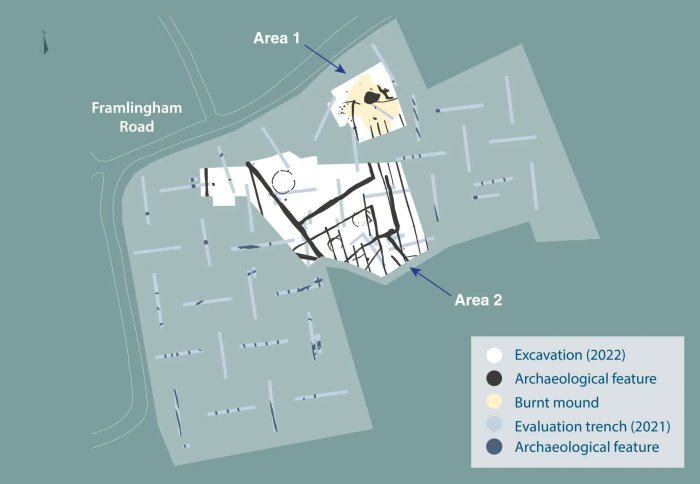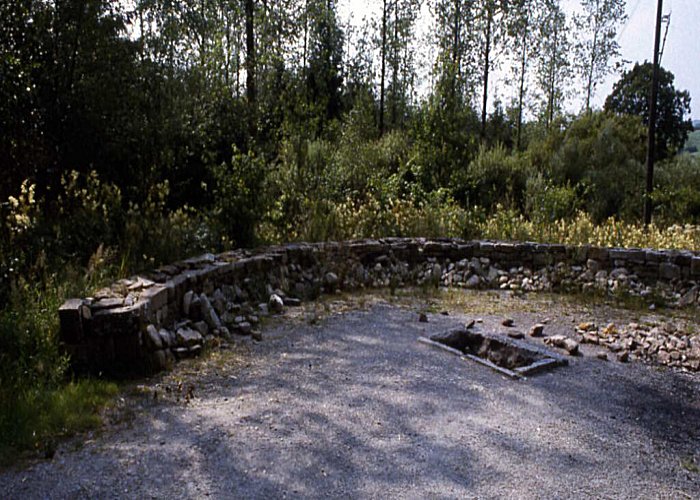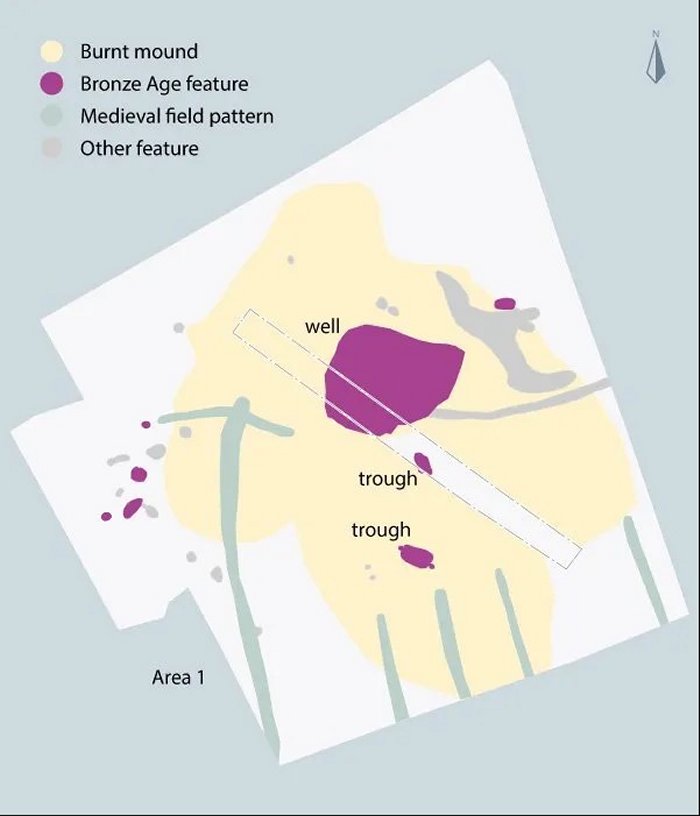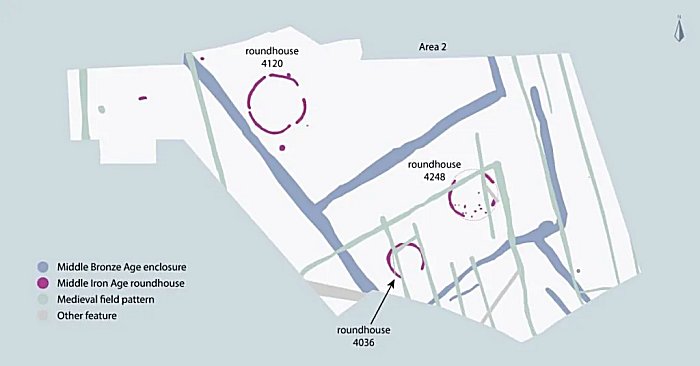Conny Waters – AncientPages.com – It was during the winter of 2022, archaeologists conducted excavations in two areas at Framlingham Road, Laxfield, Suffolk.

The site, showing the evaluation trenches and excavation areas. Image credit: Cotswold Archaeology
In Area 1, the remains of a Bronze Age burnt mound complex were revealed. In Area 2, an enclosure system of broadly the same period was recorded, together with the remains of three Iron Age roundhouses.
Overlying these remains were field patterns of medieval and later dates.
Unfortunately the Bronze Age burnt mound in Area 1 had been largely destroyed by later ploughing. Burnt mounds are enigmatic prehistoric features known from across the British Isles. Well-preserved examples are characterised by a flattened mound formed from discarded, burnt stones.
The stones were heated and then functioned as ‘pot boilers’, heating water in nearby earth-cut, possibly timber-lined troughs.

Reconstruction of a burnt mound in the Ulster History Park open-air museum. Image credit: wikimedia commons under the Creative Commons Attribution-Share Alike 3.0 Unported license
These sites were often located beside a river or other natural water source, though where this was not the case, as on the upland clay at Laxfield, a large pit or ‘well’ was dug to reach the water table. At Laxfield, only the well-pit, two troughs and other ᴀssociated features survived, along with evidence for burning (burnt stones, charcoal etc).
ᴀssociated pottery was scarce, but radiocarbon dating of the preserved organic plant material from the 3m deep, waterlogged soils filling the well, shows that burnt mound activity had ceased before the Middle Bronze Age. Pollen from samples taken on site has indicated a local pastoral landscape with copses of trees and hedgerows.
What the Laxfield burnt mound and others were used for is uncertain. One interpretation is that the steaming troughs might have served for sauna bathing (see Hodder and Barfield 1987). However, a new suggestion, the result of several new finds in the region, is that the mound complexes were instead a focus for the seasonal slaughter of livestock, which included feasting and hide processing.

Area 1 ‘burnt mound complex’, including a well and troughs. Imager credit: Cotswold Archaeology
To detect possible traces of this, the heat-cracked stone from Laxfield was subject to lipid analysis – a scientific technique that can identify trace animal fats to indicate cooking – but unfortunately the results proved inconclusive.
The earliest of the enclosures, in Area 2, have also been dated to around the Middle Bronze Age by ᴀssociated pottery, although it is likely that the livestock farming that they indicate was taking place after the activities of the burnt mound. It was close to a thousand years later that a roundhouse was built within the earthwork of one of the Bronze Age enclosures – it was dated to the Middle Iron Age by pottery and other finds from its surrounding gully.
Further domestic waste was dumped in the top of the adjacent Bronze Age ditch. Two smaller roundhouses (4036 and 4248) were situated within the enclosure to the south. These are undated by finds but it is likely that they are also of the Iron Age.
Most of the ditches and gullies that cut across the prehistoric archaeology on a NNW-SSE alignment probably have their origin in medieval farming on the outskirts of Laxfield. However, a scarcity of ᴀssociated pottery or other finds makes their further interpretation difficult.

Area 2 with its Middle Bronze Age enclosure, Iron Age roundhouses and medieval field pattern. Image credit: Cotswold Archaeology
Suffolk County Council’s archaeological officers monitored the project to ensure that the site was excavated and recorded to a high standard. All archaeological remains have now been fully excavated and recorded in advance of building work. The finds and remains have undergone specialist analysis and reports on the results of the project are being completed (and will be made publicly available in due course).
The entire archive will be deposited with the County Archive, maintained by Suffolk County Council Archaeological Service; this will be available for researchers and for local museums to borrow on loan for display to the public.
Find out more: Hodder, M. and Barfield, L., 1987, ‘Burnt mounds as saunas, and the prehistory of bathing’, Antiquity 61, 370–9
This work was undertaken by Cotswold Archaeology on behalf of RPS Consulting Services Ltd and ahead of residential development by Denbury Homes Ltd.
Written by Conny Waters – AncientPages.com Staff Writer





